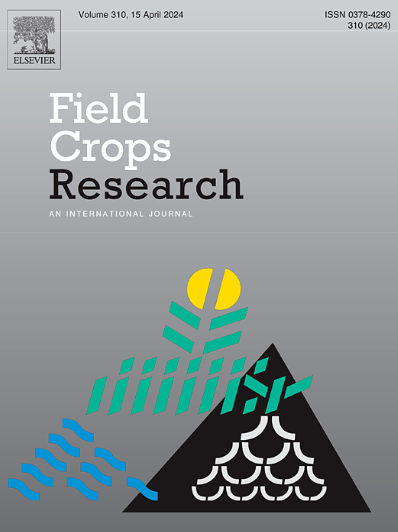1918-2023年期间泰国主要作物的产量动态:生长、停滞和气候敏感性的区域模式
IF 6.4
1区 农林科学
Q1 AGRONOMY
引用次数: 0
摘要
背景了解长期产量趋势对于指导农业政策和气候适应至关重要,但由于长期数据集有限、对次国家级停滞的分析不足以及作物对政策和气候变化的反应存在不确定性,因此仍存在重大差距。尽管泰国在东南亚的农业中扮演着关键的角色,但全面的省级规模的历史评估仍然很少。本研究旨在:(1)重建泰国水稻、玉米和大豆的长期产量趋势,(2)检测时空停滞模式,(3)评估作物对大尺度气候变率的敏感性。方法利用泰国77个省1918年至2023年的年度作物产量数据。为了捕捉长期趋势和突然变化,我们应用多项式去趋势和动态线性模型来分析产量趋势并确定断点。然后,我们评估了作物产量异常与主要气候遥相关指数之间的相关性,包括厄尔尼诺Niño-Southern涛动(ENSO)、偶极子模式指数(DMI)和南方涛动指数(SOI),以量化气候随时间和空间的影响。结果水稻产量在20世纪初下降,但在20世纪60年代以后稳步上升。玉米产量在20世纪80年代加速增长,而大豆的产量趋势仍然温和多变。68 %的水稻种植省和49 %的玉米种植省出现停滞,特别是在灌溉渠道或经济支持有限的省份。大豆滞涨较为分散。近70% %的水稻省表现出正的ENSO相关性,而玉米和大豆的响应较弱或为负。1970 - 1999年气候产量相关性最强,近几十年来逐渐减弱,可能是由于适应能力的提高或远相关行为的演变。本研究首次提供了泰国100多年次国家级产量动态分析。虽然水稻产量总体上有所提高,但玉米和大豆表现出更频繁的停滞和更高的气候敏感性。特别是在2000年之前,长期遥相关显著影响了产量变异性,突出了气候知情农业政策的重要性。研究结果支持将气候风险监测整合到早期预警系统中,并呼吁采取适应性战略,包括耐旱品种、气候适应型实践以及对停滞省份的有针对性支持。未来的工作应纳入社会经济数据,以完善局部气候适应。本文章由计算机程序翻译,如有差异,请以英文原文为准。
Yield dynamics of major crops in Thailand for the period 1918–2023: Regional patterns of growth, stagnation, and climate sensitivity
Context
Understanding long-term yield trends is essential for guiding agricultural policy and climate adaptation, yet major gaps persist due to limited long-term datasets, insufficient analysis of subnational stagnation, and uncertainties in crop responses to policy and climate variability. Although Thailand plays a critical role in Southeast Asia’s agriculture, comprehensive provincial-scale historical assessments remain scarce.
Objective
This study aims to: (1) reconstruct long-term yield trends, (2) detect spatial and temporal stagnation patterns, and (3) assess crop sensitivities to large-scale climate variability for rice, maize, and soybean in Thailand.
Methods
We used national records to compile annual crop yield data from 1918 to 2023 across 77 provinces in Thailand. To capture both long-term trends and sudden shifts, we applied polynomial detrending and dynamic linear models to analyze yield trends and identify breakpoints. We then assessed correlations between crop yield anomalies and major climate teleconnection indices, including the El Niño–Southern Oscillation (ENSO), Dipole Mode Index (DMI), and Southern Oscillation Index (SOI), to quantify climate influence over time and space.
Results
Rice yields declined in the early 20th century but rose steadily after the 1960s. Maize yields accelerated in the 1980s, while soybean trends remained modest and variable. Stagnation occurred in 68 % of rice- and 49 % of maize-growing provinces, especially where irrigation access or economic support was limited. Soybean stagnation was more scattered. Nearly 70 % of rice provinces showed positive ENSO correlations, while maize and soybean responses were weaker or negative. Climate-yield associations were strongest from 1970 to 1999, diminishing in recent decades, possibly due to improved adaptation or evolving teleconnection behavior.
Conclusion
This study provides the first over-100-year subnational analysis of yield dynamics in Thailand. While rice productivity improved overall, maize and soybean exhibited more frequent stagnation and higher climate sensitivity. Long-term teleconnections significantly influenced yield variability, especially before 2000, highlighting the importance of climate-informed agricultural policy.
Implications
The findings support the integration of climate risk monitoring into early warning systems and call for adaptive strategies, including drought-tolerant varieties, climate-resilient practices, and targeted support for stagnating provinces. Future work should incorporate socioeconomic data to refine localized climate adaptation.
求助全文
通过发布文献求助,成功后即可免费获取论文全文。
去求助
来源期刊

Field Crops Research
农林科学-农艺学
CiteScore
9.60
自引率
12.10%
发文量
307
审稿时长
46 days
期刊介绍:
Field Crops Research is an international journal publishing scientific articles on:
√ experimental and modelling research at field, farm and landscape levels
on temperate and tropical crops and cropping systems,
with a focus on crop ecology and physiology, agronomy, and plant genetics and breeding.
 求助内容:
求助内容: 应助结果提醒方式:
应助结果提醒方式:


